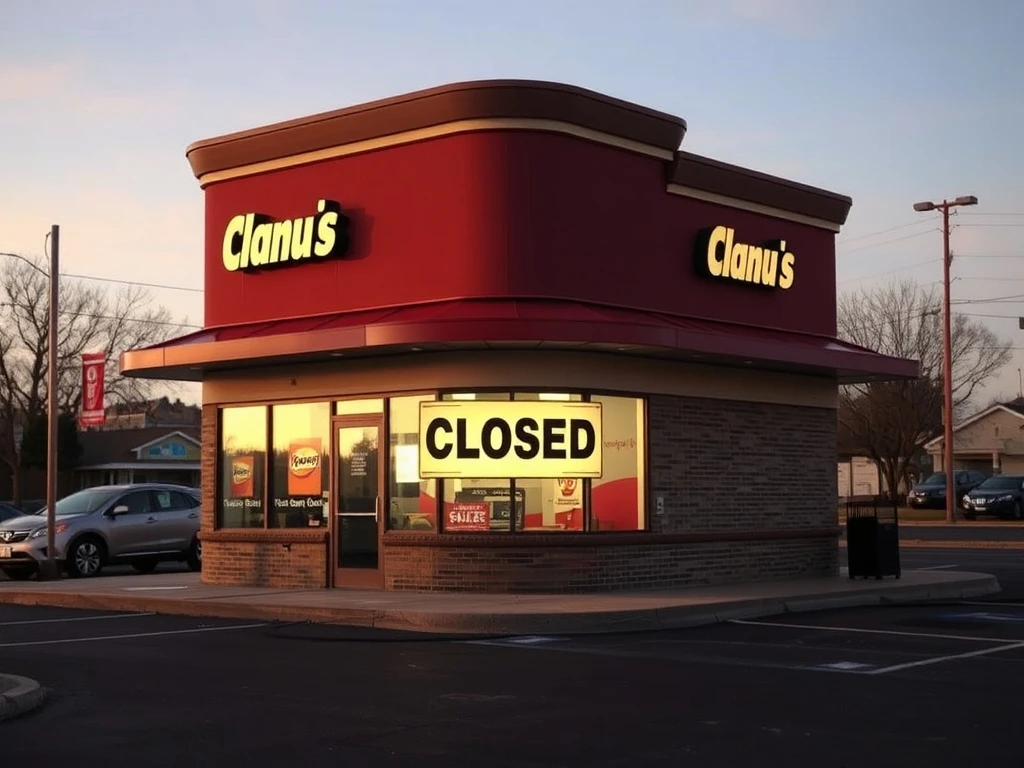The landscape of the fast-food industry is constantly shifting. However, recent news has sent ripples through the sector. A long-standing burger chain, founded in 1934, has announced the closure of 200 restaurants. This significant development highlights broader trends impacting the quick-service restaurant (QSR) segment. Understanding the reasons behind these **fast-food chain closures** is crucial for industry observers and business owners alike.
Understanding the Scope of Fast-Food Chain Closures
This historic burger chain has been a staple in communities for decades. Its origins date back to 1934, establishing a legacy spanning nearly 90 years. Therefore, the decision to shutter 200 locations is not taken lightly. It signals considerable operational difficulties. Many factors contribute to such widespread **fast-food chain closures**.
For instance, economic pressures often play a major role. High inflation rates increase operational costs. Labor expenses have also risen significantly. Furthermore, supply chain disruptions continue to pose challenges. These combined factors squeeze profit margins, especially for established brands with extensive physical footprints. Consequently, some locations become unsustainable.
The company has not yet released specific details for each closure. However, industry analysts point to underperforming stores. They also suggest locations with expiring leases are likely targets. This strategic consolidation aims to strengthen the brand’s overall financial health. Nevertheless, the impact on local communities and employees will be substantial.
Key Drivers Behind Restaurant Closures
Several overarching trends contribute to the current wave of **fast-food chain closures**. These issues are not unique to one brand. Indeed, they affect many businesses in the food service sector. Understanding these drivers provides valuable insight into the industry’s evolution.
- Changing Consumer Habits: Consumers now demand healthier options. They also seek diverse menus. Traditional fast-food offerings sometimes struggle to meet these evolving preferences.
- Increased Competition: The market is saturated with new fast-casual concepts. These often offer perceived higher quality at competitive prices. This intense competition draws customers away from legacy brands.
- Digital Transformation: The shift towards online ordering and delivery services requires significant investment. Chains must adapt quickly. Those slow to embrace technology risk falling behind.
- Rising Operating Costs: As mentioned, labor, food, and energy costs continue to climb. These expenses directly impact profitability. Businesses must find efficiencies or raise prices, which can deter customers.
Moreover, real estate costs remain a significant burden. Prime locations command high rents. Some older restaurants might occupy outdated or inefficient spaces. These properties become less viable over time. Therefore, closures can be a necessary strategic move for long-term survival. This trend of **fast-food chain closures** reflects a market correction.
The Broader Impact of Fast-Food Chain Closures on the Industry
The closure of 200 restaurants from a well-known chain sends a clear message. The fast-food industry is undergoing a profound transformation. This event affects not only the specific brand but also the broader economic landscape. Consequently, other chains are likely evaluating their own portfolios. They may also consider similar consolidation efforts.
Firstly, job losses are an immediate concern. Each restaurant employs numerous staff members. These include managers, cooks, and service personnel. The closures will displace hundreds, if not thousands, of workers. This situation creates a ripple effect in local economies. Furthermore, suppliers and distributors also feel the pinch. Their business volumes decrease as restaurants shut down.
Secondly, the closures impact commercial real estate. Vacant restaurant spaces can be difficult to fill. They often require specialized infrastructure. This can lead to empty storefronts in shopping centers. Property owners face challenges in attracting new tenants. Therefore, the economic fallout extends beyond the restaurant chain itself. The broader implications of these **fast-food chain closures** are significant.
Adapting to a Dynamic Market
Surviving in today’s fast-food market demands agility. Brands must innovate constantly. This includes menu diversification and technological upgrades. For instance, many chains now offer plant-based options. They also invest heavily in mobile apps and loyalty programs. These initiatives aim to capture new customer segments. They also retain existing ones.
The focus has shifted from expansion to optimization. Companies are now prioritizing profitability over sheer store count. They are analyzing data to identify underperforming locations. This data-driven approach helps them make informed decisions. It also allows them to allocate resources more effectively. These strategic adjustments are vital for long-term viability.
Some chains are exploring smaller footprints. They are also considering drive-thru only models. These formats reduce overhead costs. They also cater to the growing demand for convenience. The pandemic accelerated these trends. It highlighted the importance of off-premise dining. Consequently, the future of fast food might look very different. More **fast-food chain closures** could occur as the industry recalibrates.
Future Outlook for the Fast-Food Sector Amid Closures
Despite the challenges, the fast-food industry remains resilient. It continues to adapt to new realities. The current wave of **fast-food chain closures** can be seen as a cleansing process. It removes less efficient or outdated operations. This ultimately strengthens the remaining players. Innovation will continue to drive growth in the sector.
Technology will play an even larger role. Automation in kitchens could become more common. Artificial intelligence may optimize ordering and delivery. Personalization will also increase. Customers expect tailored experiences. Brands that leverage data effectively will gain a competitive edge. This includes understanding individual preferences and offering relevant promotions.
Sustainability is another growing concern. Consumers prefer brands with eco-friendly practices. This includes sourcing ingredients responsibly. It also involves reducing waste. Fast-food companies must embrace these values. Otherwise, they risk losing market share. The industry will likely see further consolidation. Stronger, more adaptable brands will emerge. This ensures continued evolution despite the ongoing **fast-food chain closures**.
In conclusion, the closure of 200 restaurants by a historic burger chain marks a pivotal moment. It reflects significant shifts within the fast-food industry. Economic pressures, evolving consumer preferences, and intense competition are driving these changes. While challenging, these **fast-food chain closures** also pave the way for innovation. They encourage greater efficiency and strategic adaptation. The industry will undoubtedly continue to evolve, with resilience and adaptability as key themes.
Frequently Asked Questions (FAQs)
Q1: Why are fast-food chains closing so many locations?
Fast-food chains are closing locations due to several factors. These include rising operating costs like labor and food prices. Changing consumer preferences also play a role, with demand for healthier and more diverse options. Intense competition from new concepts and the need for significant investment in digital transformation also contribute to closures.
Q2: What is the impact of these fast-food chain closures on the economy?
The closures have a significant economic impact. They lead to job losses for restaurant staff. They also affect suppliers and distributors who rely on these restaurants. Furthermore, vacant commercial real estate can impact local property markets. This creates a ripple effect across communities.
Q3: Are all fast-food chains experiencing these difficulties?
While many chains face similar challenges, the impact varies. Well-established brands with large footprints might find it harder to adapt quickly. Smaller, more agile, or tech-forward chains might navigate the changes more effectively. However, the underlying economic and consumer trends affect the entire industry to some extent.
Q4: How is the fast-food industry adapting to these changes?
The industry is adapting through innovation. Many chains are diversifying menus to include healthier or plant-based options. They are also investing in technology for online ordering and delivery. Furthermore, some are optimizing their store formats, such as smaller footprints or drive-thru only locations, to reduce overheads and enhance convenience.
Q5: What does the future hold for the fast-food industry?
The future of fast food will likely involve continued innovation and consolidation. Technology, including automation and AI, will play a larger role. Sustainability and personalized customer experiences will also become more critical. Stronger, more adaptable brands that prioritize efficiency and consumer trends are expected to thrive.
























